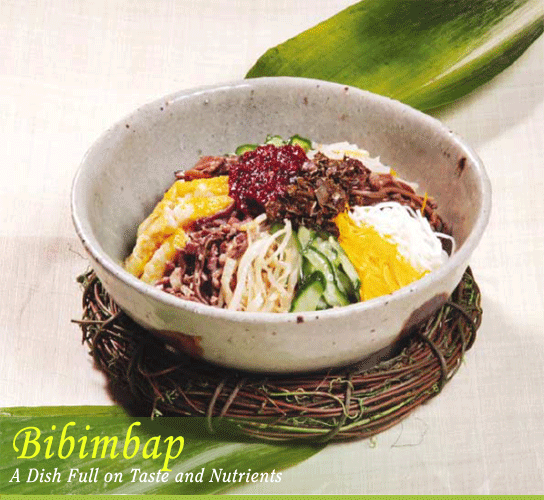|
Bibimbap
is a popular Korean dish that contains many ingredients
mixed in a bowl with rice and hot pepper paste. It is
also referred to as goldongban and is one of
the most representative Korean dishes along with bulgogi
and kimchi.
|
There was a longstanding tradition among our ancestors
that any leftover food on New Year’s Eve was not to
be kept into the New Year. For this reason, the practice
of mixing various ingredients in a bowl with rice was
started. Koreans are also known to cook many different
dishes to pay respects to their ancestors on major holidays
such as the Lunar New Year and Chuseok. Since there
is a lot of food leftover on these occasions, people
enjoy mixing them.
|
Although the recipe for bibimbap sounds rather
simple, there are regional variations and one of the
most well known is Jeonju bibimbap which
contains bean sprouts. With a growing number of health
conscious individuals, bibimbap containing fresh
shoots, wild greens or mountain herbs is also gaining
popularity. It’s not only the variation in ingredients
that make a difference. Dolsot (stone pot) bibimbap,
containing slow-cooked rice, has always been popular.
Another interesting variation is yangpun (large
brass bowl) bibimbap. As the Korean name suggests,
the large brass bowl contains enough bibimbap
to feed two to three.
|
The ingredients, an assortment of herbs and meats,
all have their own distinct flavors and tastes, but
a spoonful of hot pepper paste in the mix produces a
surprisingly pleasant taste.
|
Bibimbap is not only delicious, it also contains
a wealth of nutrients such as cellulose and vitamins
while being low in cholesterol and fat. Such healthy
dishes are ideal for all but especially so for busy
students as well as hardworking individuals always on
the go.
|
What better way to provide a simple yet nutritious
meal than to prepare tasty bibimbap for your
entire family.
|
|
|
|
|
|
Ingredients
|
- Nonglutinous Rice (320g)
= Soaked Nonglutinous
-
Rice (400g)
- Water (600g)
-
Beef (150g)
- Fernbrake
(150g)
- Seasoning for
Beef & Fernbrake: Soy
Sauce (51g), Sugar (19.5g),
Green Onions, chopped (20g),
Garlic, chopped (10g), Powdered
Sesame mixed with Salt (9g),
Ground Pepper (1g), Sesame
Oil (12g)
- Cucumber
(200g)
- Ballonflower
(150g)
- Seasoning for
Cucumber & Ballonflower:
Soy Sauce (11g), Green Onions,
chopped (20g), Garlic, Chopped
(10g), Powdered Sesame mixed
with Salt (18g), Sesame
Oil (24g)
- Bean Sprouts
(150g)
- Seasoning for
Bean Sprouts: Salt (1.6g),
Sesame Oil (3g), Fish (Croaker,
Cod or Frozen Pollack) (150g)
-
Seasoning for Fish: Salt
(1.6g), Ground Pepper (1g),
Flour (18g), Eggs (110g),
Kelp (10g), Vegetable Oil
(50g)
- Hot Pepper Paste
(80g)
|
|
|
|
|
|
|
|
Cooking Instructions
|
1.Thoroughly wash rice and soak in water for 30~60
minutes and then cook.
|
2.Cut beef into 5cm long pieces and clean and cut
fernbrakes into 4~5cm pieces. Using the seasoning ingredients
listed above, mix into beef and fernbrakes. Remember
to keep them separated. Next, panfry the beef and fernbrakes
separately using vegetable oil.
|
3.The next step is to take the cucumber and to diagonally
slice it into half. Then, slice into approximately 0.3cm
thick pieces. When you have thinly sliced cucumbers,
season with salt and then drain the liquid by squeezing
with your hands. Rub salt into balloonflowers and then
clean in water. Then diagonally rip them into thin slices.
Use the ingredients listed above to season each ingredient
and then panfry separately.
|
4.Bean sprouts should be cleaned and placed in a
pot along with some water and salt and slightly cooked.
Once cooked, use the seasoning instructions listed above
to complete.
|
5.Take the fish meat and cut into 4cm by 5cm pieces
and season with salt and pepper. Next, cover with a
coat of flour and then drench it in a coat of eggs.
Next, panfry the fish pieces and cut into 1cm wide pieces.
Fry the leftover eggs to cook and slice them.
Cook
the kelp and panfry in oil until crispy. Break the crispy
kelp into small pieces using your hands.
|
6.Using a bowl, place the ingredients nicely on top
of rice. Serve a bit of the hot pepper paste separately.
|
|
The article courtesy of Seoul
magazine
Source:
http://english.visitkorea.or.kr/enu/FO/FO_EN_6_5_2_3.jsp
|


No comments:
Post a Comment